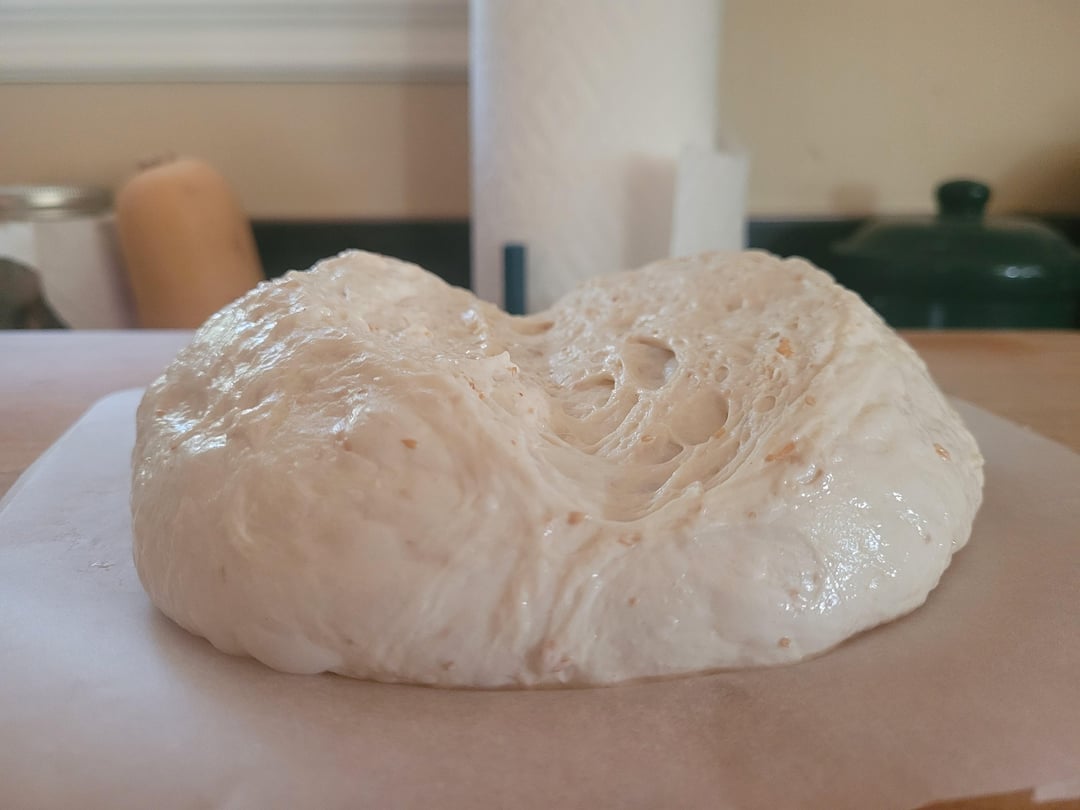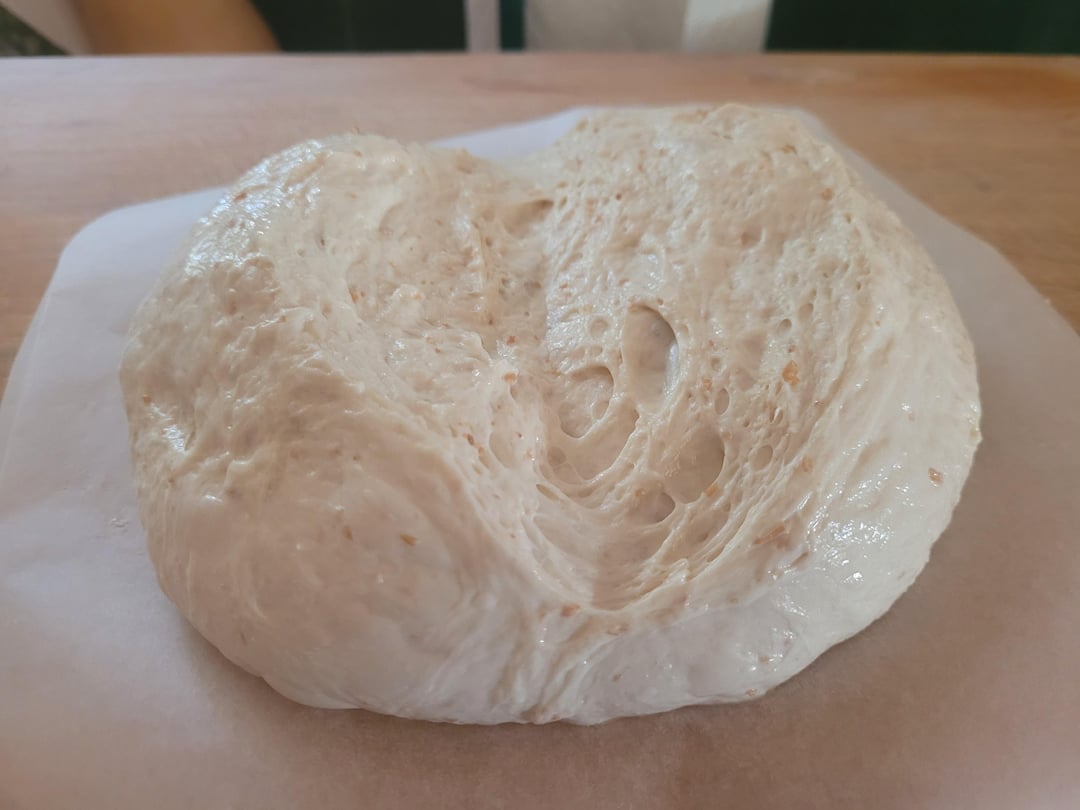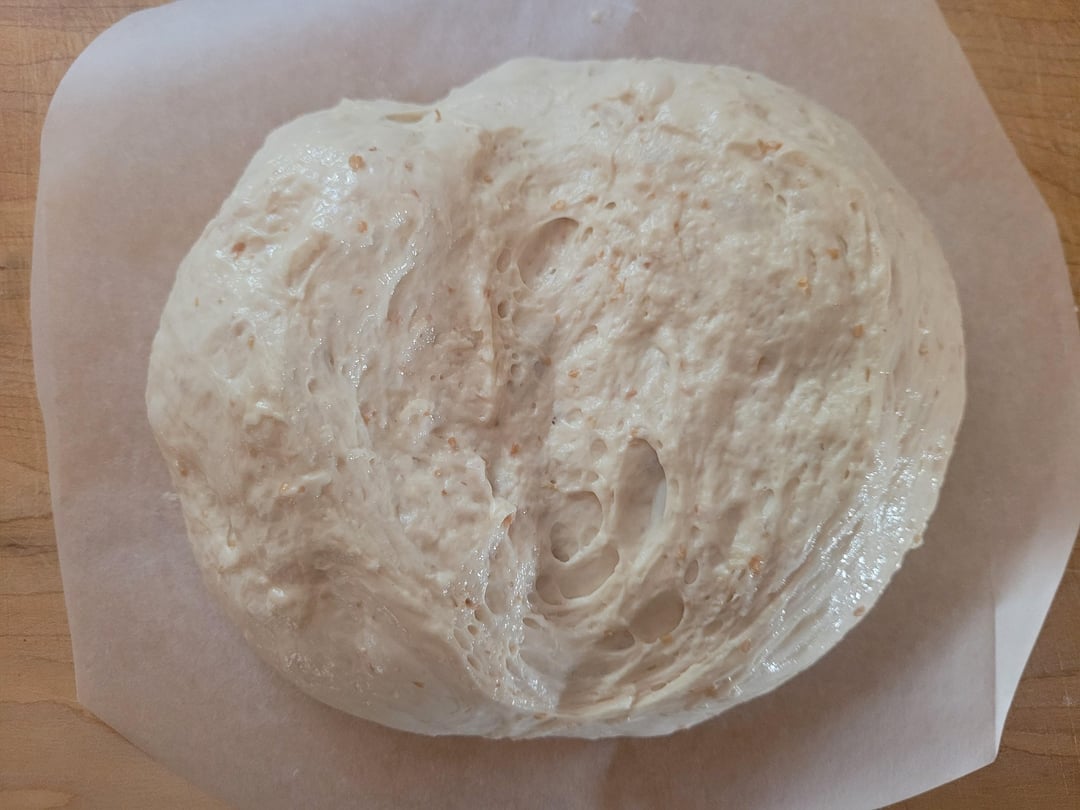


My texture is obviously off, or something is off anyway. When I score it doesn't look like any of the videos I watch. It just melts outwards. This one I scored particularly deep to try and see if that helped, it did not. Usually I don't score this deep though and same issue, every time same issue. Bread seems fine when it comes put but I've been doing this a while and I'm ready to up my game.
So, I'm just putting this loaf #1 in the oven now, I have loaf #2 in the fridge ready to bake next. Anything I can do to improve scoring on the 2nd one?
Recipe/method:
Mix 100g mature starter, 375g water, 450g white flour, 50g whole wheat flour. Wait 1 hour in oven with light on.
Add 10g water and 10g salt. Gently knead. Wait 1 hour covered in oven with light on.
4 sets of stretch and folds, half an hour between each, keeping covered in oven with light on in between.
30 mins after final stretch and fold, lay dough out on work surface and cut in two. Preshape into rounds. Place each loaf tension/top side down in a clean, dry mixing bowl.
Proof overnight in fridge.
Take out of fridge, drop dough onto parchment sheet. Clean up edges to keep round shape. Score with razor blade.
Bake 450 deg dutch oven 20 min, lid off down to 375 deg until done.
by Phellle

32 Comments
I wonder why it’s looking so wet? The recipe looks good. Maybe you’re cutting too deep.
Do you know what the temp is in your oven with the light on?
I proof my bread in my oven, but I only need the lights to be on for about 10 minutes every 2 hours or so. If I leave the lights on, the temp will get over 110°
I suspect your bread is overproofing. If your intention was focaccia, you’d be golden lol.
I recently started baking sourdoughs, with 0 baking background, I had a similar problem the first time I made a sourdough and noticed that the issue was that I didn’t wait for the dough to double in size before shaping and placing it in the banneton to let proof in the fridge. Made the biggest difference for me. The dough actually held shape and I flour the bottom and top before placing it in the fridge and flour it again when I pop it out of the fridge to score. Hope this helps!
On a side note, I’ve only made 3 sourdoughs so far and the second one was a huge success. Third one wasn’t as good cause I experimented with AP flour rather than bread flour.
Seems like WAY too much water for that amount of flour. Your dough should hold it’s shape once you get to the point of scoring it, but it looks like it way too wet. High hydration recipes are notoriously hard to work with and hard to master.
Try 100 grams of starter, 350 grams of water and 500 grams of flour. And don’t shape it into two loaves. Those amounts are intended for one loaf, not two.
A few things I can think of
You can lower the hydration a little, that might make it easier to work with
The shaping looks off – are you getting a nice firm ball with a tight outside before you fridge?
Can you tell what % the dough has increased before you shape it? Proofing in a straight sided container can make it easier to tell
Is your fridge cold enough? Sometimes if your fridge is a little too warm it can overproof overnight in the fridge.
You can try freezing the loaf for 30 minutes before you turn it out and score it
Good luck! I know it’s frustrating but don’t give up
You seem to be missing a bulk ferment/initial proof stage. From your method, you add all your ingredients and let sit for an hour before doing your folds and then cut and shape it right away. You need to allow the dough to double or close to it before you shape. Typically this takes a few hours after the last stretch and fold (like 4-6 depending on things like the temperature of your kitchen and starter strength). The bulk ferment is pretty critical for the flour to absorb all the water, for the starter to get working and for the gluten to strengthen.
I’d also slightly modify your initial steps – it seems overly complex.
Mix your starter with your water, then mix in your flour. Sprinkle your salt on top of the dough (but don’t mix it in yet). Let all that sit on the counter for 20 min to autolyze/hydrate. Then mix in the salt – you can do all this by hand using pincer motions with your fingers to cut through the dough. Let sit for another 20. Do your three stretch and folds 15 or 20 min apart. Then let the dough rest covered until doubled – the 4-6 hour bulk ferment. Then do your shape and into the fridge overnight.
I agree with too high of hydration. Do a hydration test on your flour and go 10-15% less then the highest water content you can still pull a pane with and you’ve found your top end.
To help scoring your current dough throw it in the freezer for an hour or longer until the outer surface freezes. Then flip it out score quickly and off she goes.
It is NOT too much water – ignore that comment. People do 75-80% hydration loaves all the time. You just have to learn how to handle higher hydration. To me, it looks like you didn’t do enough structural development. Dial the hydration back, find a Tartine based recipe with explicit instructions, and watch the Sourdough Journey’s “The Mystery of Bulk Fermentation” youtube videos. I’m guessing you are making a random choice or the recipe developer’s choice to when BF is complete, when your dough temperature and dough will tell you when it is ready. Higher ambient and dough temps generally mean less bulk time and desired dough rise prior to shaping. Lower ambient and dough temps mean more bulk time and rise.
Stick with it and you’ll get it. It honestly took me a year and a half to come up with something good. Reading dough will become second nature.
Since you’re at about 80% hydration you’d be better off using bread flour instead of all purpose. Too much water for that flour.
To much water?
hi! after reading your steps, i think you are missing the most important part, which is the bulk fermentation! after you do your stretch and folds, you should be leaving your dough to rise at room temperature. depending on the temperature of your dough this can take anywhere from 3-10 hours and the dough should rise anywhere from 30-70% again depending on how warm it is. this process is super important to help the dough strengthen and make the dough strong, elastic, and easy to handle. once the dough has risen, THEN you can split the dough, preshape, final shape, and place in the fridge for the cold ferment which you can do anywhere from 12-48 hours in the fridge before baking. this should help tons!
i dont believe you are using too much water, your dough right now is at 75% hydration (the amount of flour divided by the amount of water gives you the hydration percentage). i usually bake mine at 80% and have never had an issue with it being too wet.
Don’t let your dough warm up. Take it out of the refrigerator, score it, then right into the oven. Do not score room temperature dough
You’re not bulk fermenting for enough time at all
Watch this video. It will simplify your life. It produces perfect sourdough every time.
https://youtu.be/e30Z1ijnWfM?si=fzcE5dpBlIxuqOgj
I’m not sure how anyone can offer advice because the photos you provided are just so far off the mark. The surface scoring is performed as a very last step, moments before popping it in the oven. After bulk ferment. After shaping into a tight shape. After flouring the dough ball. After putting into a basket and fermenting overnight. And after dumping the dough out on the counter from the basket in prep for the oven. Then, a shallow score is made with a razor.
In contrast, I’m not seeing the tension of a tight dough, the lines/creases from being upside down in a basket, the flour from the shaping process. And finally, your score resembles a deep cut in half of un-shaped dough vs a shallow score in a shaped, tight surface.
Know what I’m saying?
Have you considered not using a chainsaw?!
It looks like you are having issues shaping. It should have more surface tension. Does your dough stick to the bowl after you shape it? It might help to get a banneton or put a floured cloth in your bowl. I also like to add a little extra flour before I score to help me get a better score.
What might also help is proofing overnight in the fridge using a linen-lined banetton. I rub mine with rice flour and use a plastic shower cap to cover. The linen draws some of the water out of the dough touching it so you get a dry outer skin when you flip it out the next morning.
You are using 100g more water than I do for the same amount of flour. Lower your hydration.
Are you proofing for some period after scoring? This is the only thing I can think of that would lead to a loaf looking like this, aside from just a really deep score…
Do you live somewhere hot and humid? I’m in south Florida and I had to lower my hydration and proof only for like 2 hours. All of the recipes online were proofing WAY too long for me. Hope this helps.
Your hydration level is 80%, you need to have strong enough flour to handle that. What kind of flour do you use and which protein percentage does it have?
I think it is too wet, and overproofed. It looks like all the air is going out of it when you score it.
You appear to be missing a pretty important step. Edited in below:
>Recipe/method:
> – Mix 100g mature starter, 375g water, 450g white flour, 50g whole wheat flour. Wait 1 hour in oven with light on.
> – Add 10g water and 10g salt. Gently knead. Wait 1 hour covered in oven with light on.
> – 4 sets of stretch and folds, half an hour between each, keeping covered in oven with light on in between.
>- **BULK FERMENT**
>- ~~30 mins after final stretch and fold,~~ lay dough out on work surface and cut in two. Preshape into rounds. Place each loaf tension/top side down in a clean, dry mixing bowl. (**if you’re shaping two loaves, preshape and final shape is a good idea**).
>- Proof overnight in fridge.
>- Take out of fridge, drop dough onto parchment sheet. Clean up edges to keep round shape. Score with razor blade.
>- Bake 450 deg dutch oven 20 min, lid off down to 375 deg until done.
Commenting on PLEASE HELP! This happens EVERY time I score….
Leave it on the counter instead of in the oven during autolyze and the s&f / cf. I would also lower the salt a bit. I don’t know how big the bowl is when you put it in the fridge but you could try something that will keep it from relaxing too much and stitching it before the CR and again before you bake it.
How long is it total between steps 1 and 5? It should be in the general ballpark of 7 hours.
I don’t think it’s hydration. To me it looks underproofed and too deeply scored (should only score to half an inch or an inch deep). After scoring, right into the oven while cold. No waiting.
Most people here assume you’re in the US, using a flour with 15% protein. However, European flours typically have 11% protein. From my experience, these flours handle 15-20% less water. If this is your situation, consider using less water than the recipes suggest. In fact, as others have recommended, it’s generally easier to start with a smaller amount of water and slowly add more in the next batches.
Now serious question, did you score it with an axe perhaps?
How deep did you cut? Put no pressure on the knife, let the blade do all the work.
UPDATE: Bread’s out of the oven. Here is what it looks like. This is the bread from my original post, with the big gaping score down the middle.
https://preview.redd.it/a5mikw9b1bwc1.jpeg?width=4032&format=pjpg&auto=webp&s=efea444efa55cc35b950c9b7dfa141fb0ee95c2a
Thank you guys so much for the replies! I don’t want to completely change my entire recipe since I’m trying to learn to read the dough, so I think I’ll just alter 1 or 2 variables at a time.
First thing is adding the bulk ferment post stretch and folds that I didn’t know I was missing.
Second thing is the starter in the oven with the light on, I think from the feedback here is just too much.
I really appreciate all the replies, this has been super helpful to read through! & I’ll try to get a banneton at some point in the future as well.
https://youtu.be/x1EBQclnVYU?si=k1syVsdtWGz9CS08
This one works like a charm